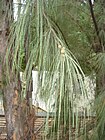Note: This is a project under development. The articles on this wiki are just being initiated and broadly incomplete. You can Help creating new pages.
Difference between revisions of "Casuarina equisetifolia"
| Line 1: | Line 1: | ||
[[Image:Casuarina equisetifolia - Darwin NT.jpg|thumb|right]] | [[Image:Casuarina equisetifolia - Darwin NT.jpg|thumb|right]] | ||
| + | '''Casuarina equisetifolia''' is an evergreen tree with a finely branched, feathery crown, usually growing from 6 to 35 metres tall. The straight, cylindrical bole can be free of branches for 10 metres or more and 20 - 100cm in diameter. | ||
==Uses== | ==Uses== | ||
| − | {{Uses|}}, {{Uses|}}, {{Uses|}}, {{Uses| | + | {{Uses|Dysentery}}, {{Uses|Diarrhoea}}, {{Uses|Stomachache}}, {{Uses|Swelling}}. |
==Parts Used== | ==Parts Used== | ||
| Line 28: | Line 29: | ||
==Habit== | ==Habit== | ||
| − | {{Habit|}} | + | {{Habit|Evergreen tree}} |
==Identification== | ==Identification== | ||
| Line 47: | Line 48: | ||
==Mode of Propagation== | ==Mode of Propagation== | ||
| − | {{Propagation|}} | + | {{Propagation|Seeds}}, {{Propagation|Cuttings}}. |
==How to plant/cultivate== | ==How to plant/cultivate== | ||
| − | <ref name="How to plant/cultivate"/> | + | Common ru is adaptable to a wide range of conditions, being found from the semi-arid to subhumid tropics and subtropics, usually near sea level but succeeding under cultivation at heights up to 1,400 metres.<ref name="How to plant/cultivate"/> |
==Commonly seen growing in areas== | ==Commonly seen growing in areas== | ||
| − | {{Commonly seen|}}, {{Commonly seen| | + | {{Commonly seen|Found on sand dunes}}, {{Commonly seen|Inland to lower hills}}. |
==Photo Gallery== | ==Photo Gallery== | ||
| Line 67: | Line 68: | ||
<references> | <references> | ||
| − | <ref name="chemical composition">[ | + | <ref name="chemical composition">[Chemistry]</ref> |
| − | <ref name="Leaf">[ | + | <ref name="Leaf">[Morphology]</ref> |
| − | <ref name="How to plant/cultivate">[ | + | <ref name="How to plant/cultivate">[http://www.tropical.theferns.info/viewtropical.php?id=Casuarina+equisetifolia Cultivation]</ref> |
</references> | </references> | ||
==External Links== | ==External Links== | ||
| − | * [ ] | + | * [https://wiki.bugwood.org/Casuarina_equisetifolia Casuarina equisetifolia on bugwood.org] |
| − | * [ ] | + | * [https://www.cabi.org/isc/datasheet/16718 Casuarina equisetifolia on cabi.org] |
| − | + | ||
[[Category:Herbs]] | [[Category:Herbs]] | ||
[[Category:Pages without herbs images]] | [[Category:Pages without herbs images]] | ||
Revision as of 17:38, 10 April 2020
Casuarina equisetifolia is an evergreen tree with a finely branched, feathery crown, usually growing from 6 to 35 metres tall. The straight, cylindrical bole can be free of branches for 10 metres or more and 20 - 100cm in diameter.
Contents
- 1 Uses
- 2 Parts Used
- 3 Chemical Composition
- 4 Common names
- 5 Properties
- 6 Habit
- 7 Identification
- 8 List of Ayurvedic medicine in which the herb is used
- 9 Where to get the saplings
- 10 Mode of Propagation
- 11 How to plant/cultivate
- 12 Commonly seen growing in areas
- 13 Photo Gallery
- 14 References
- 15 External Links
Uses
Dysentery, Diarrhoea, Stomachache, Swelling.
Parts Used
[[:Category:Herbs with used in medicine|]], stem, leaves, Root.
Chemical Composition
Common names
| Language | Common name |
|---|---|
| Kannada | |
| Hindi | |
| Malayalam | |
| Tamil | |
| Telugu | |
| Marathi | |
| Gujarathi | |
| Punjabi | |
| Kashmiri | |
| Sanskrit | |
| English |
Properties
Reference: Dravya - Substance, Rasa - Taste, Guna - Qualities, Veerya - Potency, Vipaka - Post-digesion effect, Karma - Pharmacological activity, Prabhava - Therepeutics.
Dravya
Rasa
Guna
Veerya
Vipaka
Karma
Prabhava
Habit
Identification
Leaf
| Kind | Shape | Feature |
|---|---|---|
Flower
| Type | Size | Color and composition | Stamen | More information |
|---|---|---|---|---|
| {{{5}}} |
Fruit
| Type | Size | Mass | Appearance | Seeds | More information |
|---|---|---|---|---|---|
Other features
List of Ayurvedic medicine in which the herb is used
Where to get the saplings
Mode of Propagation
How to plant/cultivate
Common ru is adaptable to a wide range of conditions, being found from the semi-arid to subhumid tropics and subtropics, usually near sea level but succeeding under cultivation at heights up to 1,400 metres.[3]
Commonly seen growing in areas
Found on sand dunes, Inland to lower hills.
Photo Gallery
References
- ↑ [Chemistry]
- ↑ [Morphology]
- ↑ Cultivation
External Links
- Ayurvedic Herbs known to be helpful to treat Dysentery
- Ayurvedic Herbs known to be helpful to treat Diarrhoea
- Ayurvedic Herbs known to be helpful to treat Stomachache
- Ayurvedic Herbs known to be helpful to treat Swelling
- Herbs with used in medicine
- Herbs with stem used in medicine
- Herbs with leaves used in medicine
- Herbs with Root used in medicine
- Habit - Evergreen tree
- Index of Plants which can be propagated by Seeds
- Index of Plants which can be propagated by Cuttings
- Herbs that are commonly seen in the region of Found on sand dunes
- Herbs that are commonly seen in the region of Inland to lower hills
- Herbs
- Pages without herbs images





